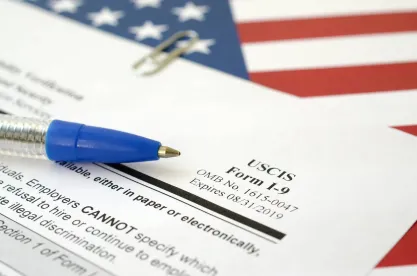This week, the Department of Homeland Security (DHS) issued a new final rule on the Form I-9 process. Under the new rule, the DHS Secretary may authorize alternative Form I-9 documentation examination procedures that do not require an employer to physically examine an employee’s documents in person. These alternative procedures can be authorized as part of a pilot program, or upon a determination by DHS that the procedures offer an equivalent level of security, or as a temporary measure to address a public health emergency or national emergency.
Simultaneously, DHS has authorized an alternative procedure that, under certain circumstances, gives “qualified” employers the option to virtually examine the employee’s documents when completing the Form I-9. According to DHS, this new procedure was approved because it includes measures that offer a level of security at least equivalent to that provided by the existing in-person physical document examination requirement.
Separately, DHS also announced that it will publish a revised edition of the Form I-9, which employers may use beginning August 1, 2023. The revised form contains several significant changes, including the addition of a checkbox to indicate that the new alternative document examination procedure was used. Employers can continue to use the current edition of the Form I-9 (rev. date 10/21/19) through October 31, 2023, but must use the new form beginning November 1.
What does the new alternative document examination procedure entail?
If a qualified employer (see below for who is qualified) uses the alternative procedure, it must, with within three business days of the employee’s hire:
-
Examine copies of the employee’s documents (front and back) to ensure that the documents presented reasonably appear to be genuine;
-
Conduct a live video interaction with the employee to further ensure that the documents appear to be genuine and related to the employee. The employee must (1) send a copy of the document(s) to the employer and (2) present the same document(s) during the live video interaction; and
-
Indicate on the Form I-9 that the alternative procedure was used.
Employers must also retain clear and legible copies of the documents (front and back) and make them available in the event of a Form I-9 audit or government investigation. This is a change because retaining copies of the documents is optional under the current Form I-9 process, but it is mandatory if using the alternative procedure.
Which employers are qualified to use the new alternative procedure?
To use the alternative procedure, employers must be in good standing with E-Verify. This means that employers must (1) be enrolled in E-Verify with respect to all the hiring sites that use the alternative procedure, (2) be compliant with all the requirements of the E-Verify program, and (3) continue to be a participant in good standing in E-Verify at any time the alternative procedure is used.
Are qualified employers required to use the alternative procedure?
No, the new procedure is entirely optional. Nothing in the new procedure prevents employers from physically examining the employee documents to complete the Forms I-9.
May a qualified employer use the alternative procedure only for some employees?
Yes, but with some caveats. If employers elect to offer the alternative procedure to some employees at an E-Verify hiring site, the employer must do so consistently for all employees at that site. However, employers may offer the alternative procedure for remote hires only but continue to apply physical examination procedures to employees who work onsite or in a hybrid capacity, so long as this practice is not adopted for a discriminatory purpose.
When does the alternative procedure go into effect?
Qualifying employers may use the alternative procedure beginning August 1, 2023. Except as outlined below for employers who took advantage of the COVID-19 flexibilities, employers cannot use the alternative procedure with respect to employees hired prior to that date. Employers who are not currently using E-Verify can start using the alternative procedure as soon as they enroll in E-Verify and become a participant in good standing in the E-Verify program.
How long will the alternative procedure be in effect?
This procedure does not expire. However, DHS could make changes (including canceling this option) if it determines it needs to do so to maintain a level of security equivalent to that provided by the physical document inspection requirements.
May qualified employers use the alternative procedure to satisfy the requirement to physically examine an employee’s documents that were previously examined remotely under the COVID-19 flexibilities?
Yes, under certain circumstances. The COVID-19 flexibilities expire on July 31, 2023. DHS has previously announced that employers must perform the required follow-up physical document examinations for those employees initially processed remotely by no later than August 30, 2023.
However, qualified employers can now use the alternative procedure instead of conducting a physical examination if (1) the employer was enrolled in E-Verify at the time of the remote examination of the employee’s documents; (2) the employer used E-Verify to verify the employee’s employment eligibility at that time; and (3) the remote inspection took place between March 20, 2020, and July 31, 2023. Employers who do not meet these conditions must perform the physical document examinations as previously announced.
If an employer uses the alternative procedure, is use of the new Form I-9 required?
Prior to November 1, 2023, if employers use the alternative procedure, they can use either the current or the new edition of the Form I-9. If employers use the alternative procedure and complete the current Form I-9, they should write “Alternative Procedure” in the Additional Information field in Section 2. As noted, the new Form I-9, which must be used starting November 1, will include a checkbox to indicate that the alternative procedure was utilized.





 />i
/>i

